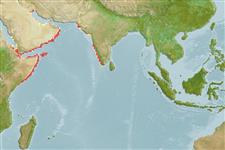Teleostei (teleosts) >
Eupercaria/misc (Various families in series Eupercaria) >
Haemulidae (Grunts) > Haemulinae
Etymology: Pomadasys: Greek, poma, -atos = cover, operculum + Greek, dasys = with hair (Ref. 45335).
More on author: Rüppell.
Environment: milieu / climate zone / depth range / distribution range
Ecology
Marine; demersal; depth range ? - 50 m (Ref. 97537). Tropical
Western Indian Ocean: Red Sea to the Gulf of Oman.
Size / Weight / Age
Maturity: Lm ? range ? - ? cm
Max length : 30.0 cm TL male/unsexed; (Ref. 11441)
Dorsal spines (total): 12; Dorsal soft rays (total): 15; Anal spines: 3; Anal soft rays: 8. Caudal fin slightly forked; silvery in color, the back with a yellow-green iridescence, with a slightly irregular, longitudinal dark brown lines on about three-fourths of body; fins dusky, the caudal darkest; a diffuse blackish blotch on membranes anteriorly in middle of pelvic fins; palate and part of sides of mouth dull orange-red (Ref. 11441).
Occurs inshore on rocky bottoms (Ref. 11441). Stomach contents of specimens collected from Iraq composed mainly of mollusks, sponges and tunicates (Ref. 97537).
Life cycle and mating behavior
Maturity | Reproduction | Spawning | Eggs | Fecundity | Larvae
Oviparous, distinct pairing during breeding (Ref. 205).
Randall, J.E., 1995. Coastal fishes of Oman. University of Hawaii Press, Honolulu, Hawaii. 439 p. (Ref. 11441)
IUCN Red List Status (Ref. 130435: Version 2024-1)
Threat to humans
Harmless
Human uses
Tools
Can't connect to MySQL database fbquizv2. Errorcode: Too many connections
